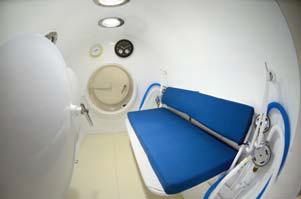Hyperbaric Oxygen Therapy (HBOT) as a ‘treatment’ for Cerebral Palsy
Keeping Current © Peter Rosenbaum, 2013
What is Cerebral Palsy

Cerebral palsy, or CP, refers to a group of developmental conditions that have several features in common (Rosenbaum, Paneth, Leviton, Goldstein, & Bax, 2007). All are associated with (caused by) some kind of injury to the developing brain. The injury can occur in the womb, during the birth of the baby, or in the first couple of years after birth (usually because of infection or trauma to the brain). In Canada, CP affects 1 in every 400 individuals and is the most common physical disability in children.
Conventional treatment and ‘management’ of CP include the advice, ideas and experience of occupational, physical and speech therapists and doctors with experience with development, as well as mechanical devices, drugs and surgery (Lacey, Stolfi, & Pilati, 2012)
There are many treatments in medicine that are referred to as ‘alternative’ or ‘complementary’ therapies. Some are simply too new to have been studied and evaluated carefully. Others are based on ideas about CP and development and human biology that are very different from how most scientists understand these issues. HBOT fits into this group of ‘therapies’, but is different because it has been very carefully studied.
What is Hyperbaric Oxygen Therapy?
Hyperbaric Oxygen Therapy (HBOT) is a technique that allows 100% oxygen to be delivered to the body's tissues under increased atmospheric pressure. To achieve this, the patient enters a "pressure chamber" that makes it possible to increase the atmospheric pressure to "hyperbaric" levels, i.e., above the earth's atmospheric pressure at sea level (Rosenbaum, Fehlings, & Iliffe, 2001).
HBOT has been approved by the US Food and Drug Administration (FDA) as an effective approach for the treatment of certain wounds, carbon monoxide poisoning and decompression illnesses in deep sea divers (e.g., the ‘bends’); however using HBOT to treat CP remains controversial and unproven (McDonagh et al., 2007).
Short Summary of the Evidence: HBOT is being used in many places around the world to treat children with CP, even though there is sound scientific evidence to show that this treatment does not work. Studies also provide information on the side effects that are associated with its use (Collet et al., 2001). In two very well-executed clinical trials comparing HBOT and ‘placebo’ treatment, HBOT has been shown to have no effectiveness for CP. Most of the other ‘evidence’ for HBOT (and often for other alternative therapies) comes from stories, or from testimonials from people who sell these treatments. The individual stories may be true but they do not constitute scientific ‘evidence’
How does HBOT work in the human body?

The air in a room usually contains 21% oxygen. In hospitals, oxygen may be given from 21% to 100% (for medical emergencies). A hyperbaric chamber can increase oxygen to a higher pressure than normal, so that more oxygen is dissolved in the blood (Rosenbaum, Fehlings, & Iliffe, 2001).
Within the body, oxygen is attached to hemoglobin (in red blood cells) and is transported by the blood. A small amount of oxygen remains “free” in the bloodstream. This “free” oxygen is used by the body’s tissues and can travel 10 to 15 times further into the tissues. HBOT increases the amount of “free” oxygen circulating in the blood. Therefore, hyperbaric oxygen (HBO) can be used to increase the delivery of oxygen to areas of the body that have been subjected to hypoxia, that is, low oxygen (Rosenbaum, Fehlings, & Iliffe, 2001).
Why is HBOT believed to be useful to treat CP?
HBOT is being used to treat CP based on the (unproven) theory that, along with damaged brain cells, people with CP have some inactive (‘dormant’) brain cells that possess the potential to recover. This recovery is thought to take place if these dormant cells are stimulated by improving oxygen availability, thereby allowing the cells to function normally and reactivating them metabolically or electrically (McDonagh et al., 2007). Current understanding of brain science does not support this seemingly appealing theory.
Improvements in spasticity, cognition, memory and attention have been reported anecdotally, but have been poorly documented. Very few evidence-based studies on the supposed benefits of HBOT have been published in peer-reviewed journals and those that are available have consistently showed no benefits (see below) (Lacey, Stolfi, & Pilati, 2012).
Why is the topic important?

Parents of children with CP may feel obligated to try every possible intervention, with the hope of ‘fixing’ their child. This means that parents can be vulnerable to claims about the effectiveness of new interventions. Some parents decide to try treatments such as HBO because they believe that they have nothing to lose, and because they are dissatisfied with the outcomes of existing interventions (Novak & Badawi, 2012). Our belief is that, in general, if something sounds too good to be true it probably is!
We believe that parents are entitled to be able to consider the latest evidence about the efficacy and effectiveness of HBOT when making decisions that involve their child’s health (Novak & Badawi, 2012). The approach taken by the writers of this review is based on principles of sound clinical science, and whatever advice is offered is presented in light of these perspectives. Professionals working to improve the health and well-being of children with CP need to have access to and evaluate evidence-based information on the potential benefits of new therapies. In doing so, they will be able to assist parents with making an informed decision regarding new treatments (Rosenbaum, Fehlings, & Iliffe, 2001).
In-Depth Summary of the Evidence
Methods
The findings included in this update are based on a recent systematic review and a meta-analysis conducted by Novak and Badawi (2012 and 2013). This review looked at the available scientific literature – both published and unpublished – in order to find and assess credible scientific evidence about the effectiveness of HBO to treat CP. Three randomized control trials were identified, which compared 40 HBOT treatments to hyperbaric air (HBA).
HBO treatment involves administration of 100% oxygen, whereas HBA involves a mixture of gases (14% oxygen) in order to provide some pressure and to simulate 21% oxygen that is present in room air (Lacey et al., 2012).
The objective of the Novak and Badawi (2012) review was to determine whether hyperbaric oxygen treatment could improve the self-care and gross motor skills of children with CP, as is claimed by the people who provide it.
Results
Collet et al (2001) conducted a large randomized controlled trial, and found no beneficial effects for HBOT in CP. The study involved 111 children with CP who, on a randomized basis, received either 40 daily ‘treatments’ of HBO at 1.75 atmospheres of pressure with 100% oxygen, or 40 daily ‘dives’ using room air (the usual air we breathe) at 1.3 atmospheres (slightly above ordinary pressure). None of the children, the families or the researchers knew which children were receiving HBO and which received the ‘pretend’ treatment until after the study was completed and analyzed.
Trained ‘masked’ observers assessed several aspects of function. These included gross and fine motor function, language skills and learning abilities. The assessments were carried out before the treatment started, after 20 treatments, after 40 treatments and again three months after the last treatment ended. The study found that both groups of children showed virtually identical amounts of change on all the functional outcomes measured. There was absolutely no extra benefit of exposure to HBO compared with the 'pretend' treatment. It was found, however, that more children in the HBO (higher pressure) group had episodes of ear pain, and that these occurred more often, than the children in the ‘control' group who had been exposed to a lower amount of increased pressure.
These findings show clearly that the apparent benefits being observed and reported from HBO cannot reasonably be attributed to pressurized oxygen, since both groups changed equally. There is no credible evidence that small amounts of increased oxygen or pressure, as experienced by the comparison (control) group, are therapeutic. Rather, the results (i.e., the observed changes in both groups) appear to reflect the effect of the hopes, expectations and extra involvement of the families with their children over the two months of ‘treatment’. Thus while one can celebrate the observed improvements seen in all the children, it is not possible to accept that these changes occurred as a result of exposure to HBO (Collet et al., 2001; Rosenbaum, Fehlings, & Iliffe, 2001).
Most recently, the Lacey et al. study (2012) consisted of a randomized double-blind controlled trial over a period of 4 years. The trial found that HBO was not associated with any significant improvement in self-care and gross motor function. The study included 49 children with CP who were randomized to receive either 40 treatments of HBO with 100% oxygen at 1.5 atmospheres of pressure or 40 treatments of HBA with 14% oxygen (similar to the air we breathe) at 1.5 atmospheres of pressure, for 8 weeks. None of the participating children, or their families, or the researchers knew which treatment each child was receiving until after the study was completed and the data were analyzed.
The primary outcome used in this study included the Gross Motor Function Measure (GMFM) global score. Other measures of outcome used included the Pediatric Evaluation of Disability (PEDI) and the Test of Variable Attention (TOVA). Assessments were conducted before the study began (to measure baseline levels of function) and after 40 treatments, as well as 3 and 6 months after the treatments ended. Results of the study demonstrated that HBO did not improve GMFM scores. In addition, both HBO and HBA were equally effective in improving PEDI scores, although the improvements observed were minimal.
It is important to note that both the Lacey and Collet studies used gold standard methods and measures, i.e. the GMFM and PEDI, to assess outcomes on data that were collected immediately after HBOT. This gave HBO the best chance of demonstrating efficacy and showing positive outcomes (Novak & Badawi, 2012).
Conversely, Packard (2000) conducted a randomized controlled trial, which demonstrated positive effects of HBOT in children with moderate to severe CP. The study was a randomized, delayed entry trial. In other words, 26 children with CP were randomized to receive 40 one-hour sessions of HBOT at 1.5 atmospheres of pressure (immediate group) or HBOT treatment only after 6 months (delayed group). In order to measure outcomes for each group, a neuro-developmental assessment, the Bayley II (a cognitive assessment), Preschool Language Scale (a language assessment), the Peabody Motor Scales (for gross and fine motors skills) and PEDI (in which parents report on mobility, self-care and social interactions) were administered. These assessments were carried out four times: at enrollment, after the ‘immediate group’ received HBOT, before the ‘delayed group’ received HBOT (5 months after enrollment), and after the ‘delayed group’ received HBOT.
While parental reports and observations during therapy reported benefits of HBOT, the blinded assessments (not knowing which group each child was in) did not show any significant benefits that could be attributed to HBOT.
Interestingly, the Packard study was not published, did not undergo any peer-review process, did not report enough statistical data, had a very small sample size and was subject to bias. Therefore, the results of this study are not considered, from a scientific perspective, to be applicable to the general population.
The meta-analysis (including all the findings from available studies) confirmed that there is no favourable benefit of HBO over HBA for improving gross motor function. In summary, although HBOT is effective in specific patient populations for specific medical conditions, it has not been proven beneficial for the treatment of CP. In fact the small number of high quality CP studies conducted conclude the opposite.
High-quality Grading of Recommendations Assessment, Development and Evaluation evidence concludes that HBOT does not have a clinically important effect on gross motor and self-care skills in children with CP (Novak & Badawi, 2012).
Risks of HBOT
Side effects (unintended consequences) of HBOT are often related to high pressure and oxygen toxicity (Muller-Bolla et al., 2006).
- Rupturing of the eardrum has been associated with hyperbaric pressure oxygen treatment (Muller-Bolla et al., 2006).
- Pneumothorax (collapsed lung) is another potential risk of HBOT. This can happen because children with CP may sometimes have a history of lung problems and experience difficulty clearing respiratory secretions (Rosenbaum, Fehlings, & Iliffe, 2001).
- Nearsightedness is a temporary side effect of HBOT that has been observed in 40% of adult patients. It usually subsides, but studies have shown that it may persist in some cases (Rosenbaum, Fehlings, & Iliffe, 2001).
- Seizures have been reported after HBOT, and could be due to oxygen toxicity. However, this does not pose a risk for children, because the recommended pressure levels used in the hyperbaric chamber are too low to produce oxygen ‘poisoning’ (Rosenbaum, Fehlings, & Iliffe, 2001).
Conclusion

Based on solid clinic research evidence it can be concluded that HBO is not an effective intervention for children with CP. HBOT may, however, negatively affect respiratory functioning and hearing, as well as cause nearsightedness, ear pain and seizures. Children with CP have a short period of developmental opportunity before their motor skills plateau (Novak & Badawi, 2012). Therefore, it could be argued that providing ineffective treatment to these children is not in their best interest. Based on current research, it cannot be considered ethical to sell or recommend HBOT to children with CP (Novak & Badawi, 2012). Health care professionals and parents should focus their efforts on interventions that have been proven successful.
Want to know more?
For questions about this Keeping Current, please contact rosenbau@mcmaster.ca.
